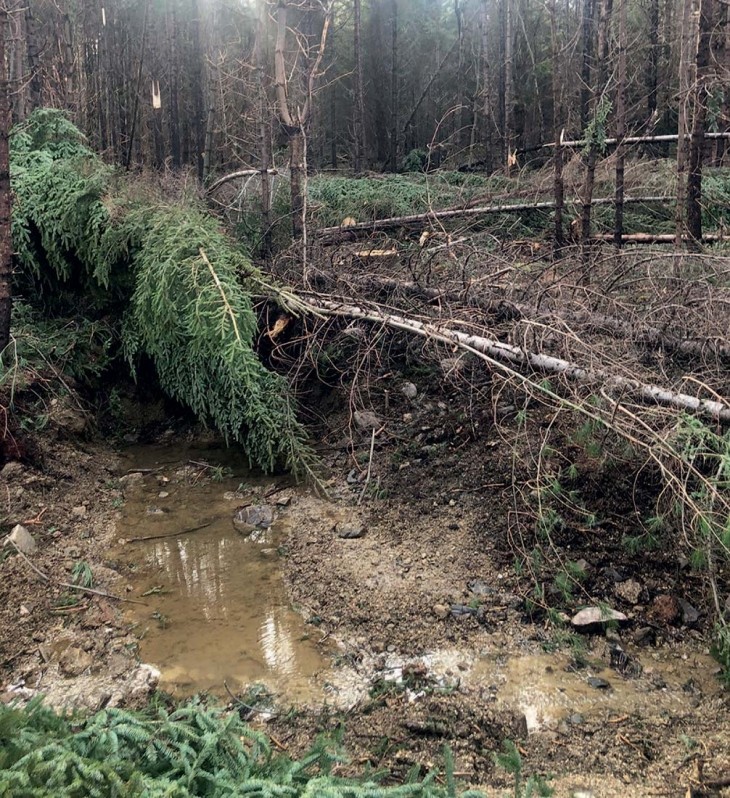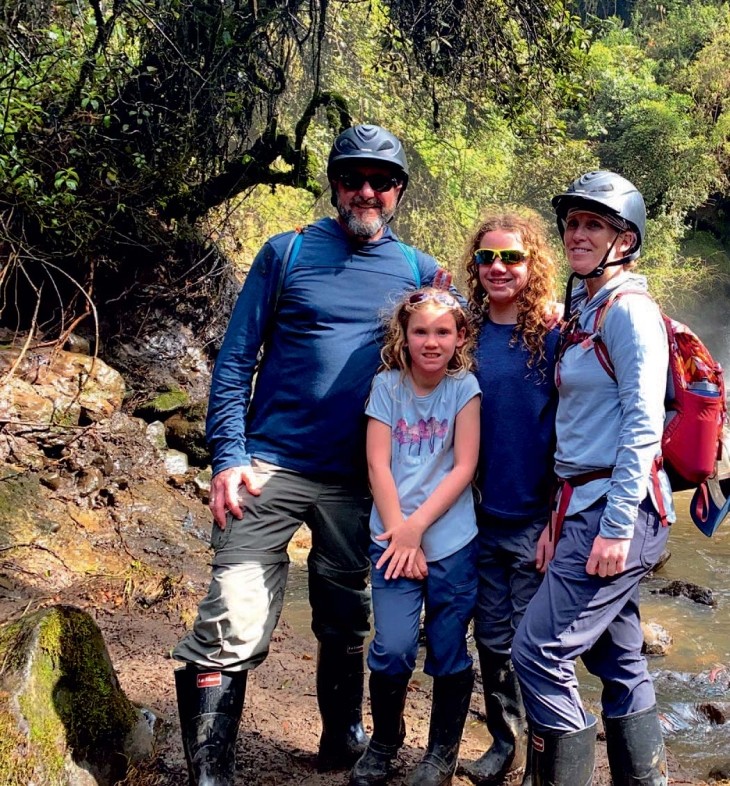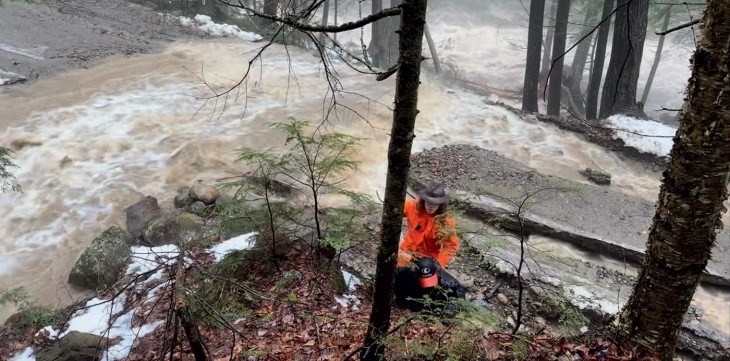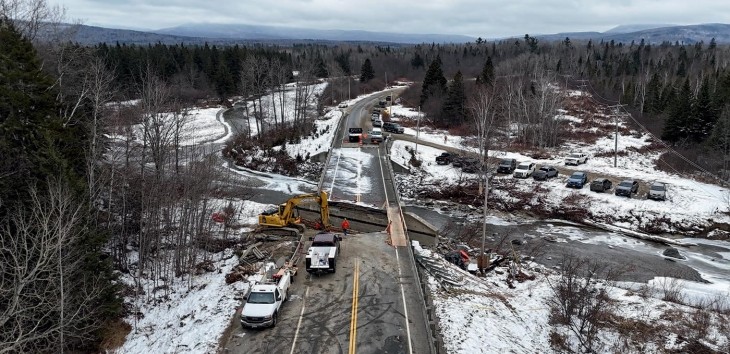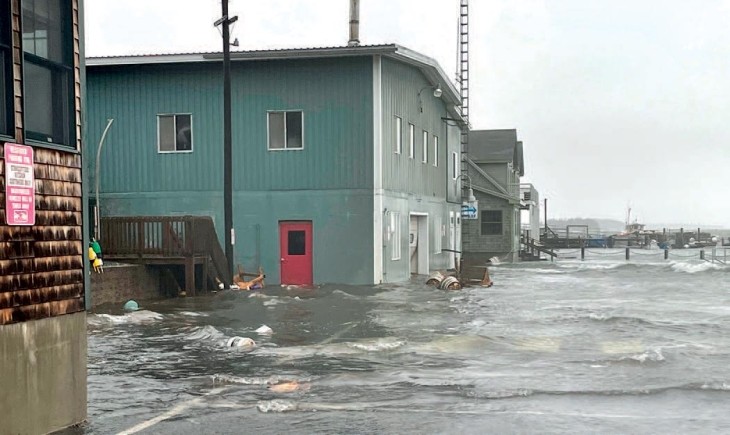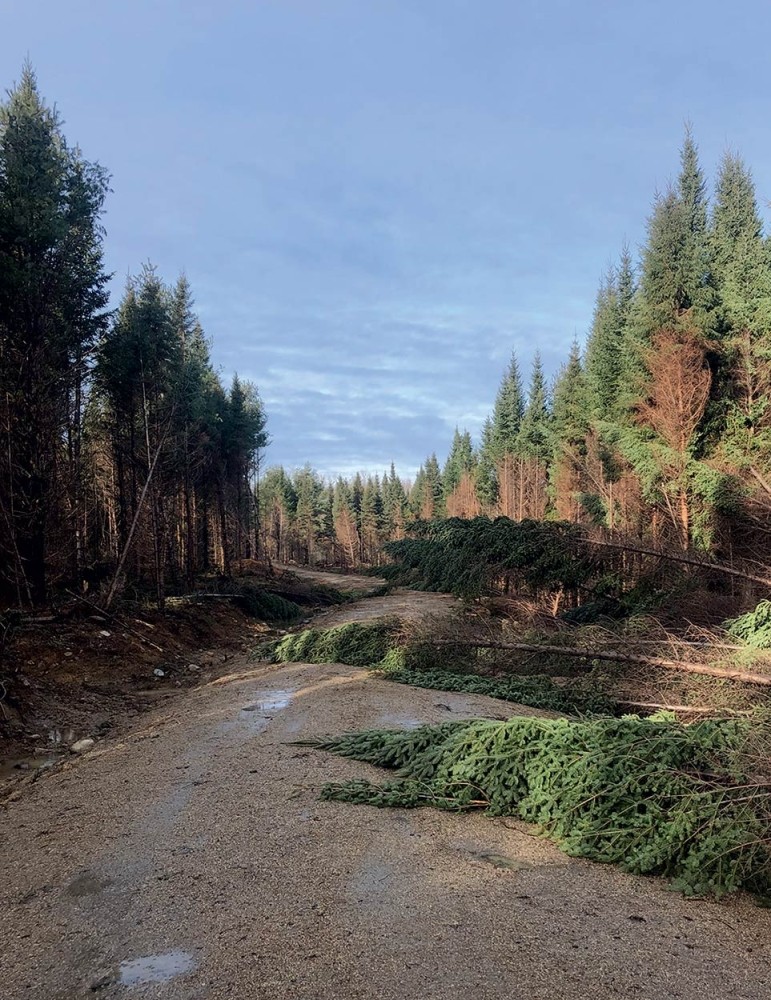
In September 2023 – after nearly 10 years of planning, clearing, and construction – Darin Schwartz, his wife Dawn Elliott, and their two children moved into the family’s “almost-completed” dream home on a 500-acre forested lot in the township of Avon, Maine. Set among the state’s western foothills, the house was 2.2 miles from the nearest public road, off the grid, and accessible by a private road that crossed a bridge spanning Mount Blue Stream.
Schwartz describes the spot as magical.
“It is really just the epitome of the beauty of Maine,” he said. “We are outdoors folks. We have an amazing view of the woods and the mountains around us and it’s quiet and peaceful – and it had a road.”
The road was essential. Abandoned by the town several years before, it provided access not just for Schwartz and his family, but also for a handful of neighboring camps and farms as well. It served as part of Franklin County’s 140-mile Moose Loop ATV trail, carrying riders, hunters, and anglers into the woods in warm weather, snowmobilers in winter. State biologists used it regularly to access one of Maine’s most productive salmon-spawning runs.
But just three months after the family moved into their home, both the road and the bridge were gone, washed out by what came to be known as the Grinch Storm of 2023.
“We had backups for our backup systems,” Schwartz said of the disaster precautions he had taken when planning and building his house. “We had over 15 years of planning on how to live in the woods, 10 years of planning this house. But never had we considered a biblical flood hitting us.”
Schwartz salvaged a beam from the downed bridge and laid it across the stream, so that he could walk out to the public road. He hung airplane cable above the beam, anchored to trees on either side. The family used the cable to trolley goods across – and to secure the kids with safety harnesses, so they could walk across the beam to school. But the beam disappeared with the next rainfall, and the harness cable became a temporary zip line.
Meanwhile, with trucks unable to reach the property, the house ran out of propane in January.
“That was a big challenge that we had to overcome,” Schwartz said, admitting that, for the first time, he seriously considered abandoning the house until spring returned. Eventually the family found an old logging trail on the back of the property that they could use to walk in and out from the main road. Although it was impassable for their Subaru, they were able to ferry supplies in and out using an amphibious, tracked ATV.
“I ended up using the Argo to pull a motorcycle trailer where I stacked six 100-pound tanks at a time,” Schwarz said. It wasn’t easy, but it kept the house warm – and occupied – through an unprecedented winter of wind, rain, snow, and ice.
Forest ownership has always come with financial risks. But with the increasing frequency and intensity of extreme weather events, even the most committed landowners face challenges to their ability to steward the woods for recreational uses, conservation, wildlife habitat, or even just the preservation of magical spaces. While addressing the effects of climate change is a long game, Maine’s recent experience suggests there may be opportunities to provide more immediate support through the innovative use of existing public policy – in this case, by leveraging an obscure program from the 2008 Farm Bill – to help private woodlot owners rebuild and recover after a disaster strikes.
You’re a Mean one, Mr. Grinch
The storm that cut off Schwartz and his family from the world began early on December 17 as an “inland runner.” That’s the name local meteorologists give to powerful storms that cut a western path through Maine, unlike their better-known coastal cousins, the Nor’easters. This one brought sustained winds of up to 60 miles per hour to five heavily forested counties west of Interstate 95, while Downeast communities reported all-day gusting of between 70 and 90 miles an hour. A weather spotter between Lubec and Eastport reported gusts that surpassed 100 miles per hour at the height of the tempest.
But the wind wasn’t the worst of it. Much of the state had been experiencing unseasonably warm weather, and the storm dumped 7 inches of cold rain across an unfrozen, saturated landscape. Brooks and rivers quickly overran their banks, taking out more than 100 roads and 20 bridges – including the critical Route 16 bridge connecting Rangeley and Stratton. Meteorologists called it the worst flooding in the state since records began in the 1800s.
Four Mainers died that day: two from falling trees and two who drowned when their pickup truck was washed down the Swift River.
In all, some 420,000 Mainers lost power on December 18, and tens of thousands would not get it back for two weeks. An initial Federal Emergency Management Agency estimate placed damage to public infrastructure at $20 million – a figure that didn’t include damage to private homes and businesses.
Surveying its members, the Professional Logging Contractors of the Northeast reported $2.6 million in direct damages, and another $3 million in downstream impacts to the local economy.
And then – just as thousands of people like Schwartz and Elliot began the daunting task of picking up the pieces – it happened again. And again.
Two more storms rode up the Eastern Seaboard between January 9 and 13, subjecting the state to additional bouts of hurricane-force winds and driving rains. Where the December storm’s wrath focused on the western counties, the twin January storms pummeled the Maine coast, and storm surges left most coastal towns looking as though they’d been bombed. The Maine Emergency Management Agency estimated that these storms produced another $70 million in damages. By March, President Biden had issued federal disaster declarations for all 16 Maine counties.
“Our foresters say we experienced forces we haven’t seen in 100 years,” said Nicole Nygren, executive director of the Downeast Lakes Land Trust, which manages 57,703 acres of forest in Washington County. “Locals tell us they hadn’t seen a storm of this size and strength in their lifetime. And then there were three.”
“We are used to storms, of course, but not the kind of storms and the kind of damage that we’ve seen with these,” said Tom Doak, head of Maine Woodland Owners, a membership organization that promotes forest stewardship and represents the interests of private forest landowners across the state. “Before, it was so localized...you know, a microburst comes into a little place and wipes out a bunch of trees in 5 or 10 acres or something. But I don’t think we’ve seen anything on the scale that we saw this last winter.”
A Hole in the Safety Net
Like Schwartz, many of Maine’s small woodlot owners – who together own about 30 percent of the state’s forested lands – were unprepared for the level of devastation the winter storms produced. Given conditions that featured powerful winds out of the south and saturated soil, significant tree loss was inevitable, Doak said. But the larger problem for many landowners was the destruction of privately-owned trails, bridges, and roads that provided access to the woods.
Without the capital to repair and replace the infrastructure, there would be no timber harvests or other forestry activities requiring logging machines and trucks. The damage also cut off access for emergency vehicles, ATV use, and vehicle access to support recreation activities such as hiking and hunting.
“Many of these people are land rich and cash poor,” Doak explained. Whereas in the past, small woodlot owners counted on salvaging logs to defray some of the costs of damage caused by natural disasters, that’s no longer feasible in a world where loggers use multimillion-dollar pieces of harvesting equipment.
“It’s just not cost effective to move this huge equipment in for relatively small cleanup operations,” Doak said. “It costs more to move it and set it up than it provides in return.”
Maine Woodland Owners Outreach Coordinator Jennifer Hicks said the group initially was caught off-guard by the statewide impacts “until the Maine Emergency Management Agency approached us.” The agency was trying to provide a comprehensive estimate of storm-related damages and asked Hicks if her organization had surveyed members.
“They wanted to know more about any monetary loss due to large-scale tree loss, but we didn’t have – at that point – any direct contact with members about damage,” she said. “Then we realized, yeah, actually, this could be something that we can address.” The next morning, she sent an email with a short form to her members asking for damage assessments, and when the responses began to arrive – in some cases, within hours – the toll was stunning.
“Multiple trees down. Can’t count them all. Many large trees uprooted and then took down all trees in its path,” a respondent from Robbinston, a town on Passamaquoddy Bay, reported. “These jumbles of trees will be a struggle to clear and remove. It is a shame, larger ones are saw logs, but how to get them out? Existing woods trails and roadways are blocked in many places. These have to be cleared first to get to damaged areas. Estimate it will take two years of landowner work to get thru it all.”
“Lost about 12M [12,000 board feet] grade pine on one lot; lost about 5M pine on another lot, and maybe 20 tons of hardwood and hemlock,” another member wrote from China, a central Maine town outside Augusta. “Haven’t checked another two lots but lost much balsam fir.... Balsam fir tore down sap lines; will work on them. Expect more blowdowns due to number of trees with soil lifting on south side. Year-round mud seasons now; wood fiber not worth as much as crews expect for wages.”
Nygren said the Downeast Lakes Land Trust is still counting the damage. “Ballpark – at least $50,000 damage to roads and trails,” she said. “There’s an untold amount of damage to our forested tracts. Trees that were loosened by the storms will be coming down through the summer.”
In Avon, Schwartz said initial estimates to replace the bridge and road approached a half-million dollars. He started researching federal and state assistance programs because, he said, “There’s no way I’m going to be able to come up with $450,000 on my own.”
What Schwartz quickly discovered, however, is that most existing disaster programs were ill-matched for Maine’s small woodlot owners. Grants from the Federal Emergency Management Agency were restricted to replacing publicly owned infrastructure or defraying uninsured expenses to private homes. And even if he could qualify for low- and no-interest loans from the Small Business Administration, how could he pay back the principal?
For its part, the Maine Woodland Owners focused on emergency bills before the state legislature that would, if passed and signed into law by Governor Janet Mills, direct up to $50 million in funds to communities, nonprofits, and businesses to help them rebuild. Representatives from the organization provided testimony and lobbied legislators to ensure that language in the bills would include woodlot owner eligibility for benefits. However, political wrangling killed all but one of the bills, and that one didn’t gain approval until the end of the legislative session. Meanwhile, Hicks said, there wasn’t a lot of information available about disaster relief for storm damage to forests.
“If you haven’t had to deal with a problem before, you wouldn’t know what the solution might be,” Doak said.
Allies from Agriculture
A solution did exist, as it turns out, but from an unexpected source.
In the days following the three storms, Sherry Hamel, executive director of the U.S. Farm Service Agency in Maine, and Amanda May, a program manager at the agency, were reviewing loss assessment reports that county directors sent to their office. Aside from the sheer volume of damage documented, May noticed a pattern in the data.
“Our initial reports were coming from farmers,” May said, which was not in itself surprising. But, she added, “Now we were hearing from producers who had damages to cropland and to their forestland – you know, farmers who had damages to their managed woodlots.”
In past years, the Farm Service, which is part of the U.S. Department of Agriculture, had assisted individual farmers who reported woodlot damage through the Emergency Forest Restoration Program. EFRP, as it is known, was part of the 2008 farm bill and provides financial and technical assistance to owners of “Non-Industrial Private Forestland.” The program provides funds on a cost-sharing basis – usually meeting 75 percent of the expenses – to carry out emergency measures that restore forest health and repair or replace resources damaged by natural disasters.
May said that historically, the program served only a handful of woodland owners at any one time.
“Typically, it’s one storm in one county,” she said. “This was three storms that happened in succession, the first hitting inland Maine and the next two hitting coastal Maine. So we were receiving applications from York County (in the south) clear up to the southern part of Aroostook County.”
Hamel and May knew that gaining federal approval to implement the program on a county-by-county basis would be onerous for staff and time-consuming for applicants, so they took three unprecedented steps.
First, they decided to compile and combine the county data into a single request for statewide approval. Second, they were able to cut through some of the red tape with support from the national office.
For a typical application for federal support, the agency would provide extensive documentation, including such details as an estimate of the number of people likely to sign up for relief, and projections of costs. “In this case, we gave them verbal notification,” said May. “They said, ‘Go ahead and implement the program and submit the paperwork supporting the request after the fact.’”
Finally, realizing that woodlot owners might not think of the Farm Service Agency as a source of help, Hamel and May worked to get the word out. They contacted colleagues in the Maine Forest Service, connected with organizations such as Maine Woodland Owners, and sent press releases to local media via county emergency management agency offices (which keep updated lists of media contacts in their communities).
Then they crossed their fingers.
Now Comes the Hard Work
Their efforts seem to have paid off. Based on the scattered information they had in late January, Hamel and May estimated that the program would see 57 applicants seeking $760,000 in assistance. But when the June 24 deadline arrived, the number of actual applicants doubled to 119, and the documented need totaled nearly $6.9 million. And more requests continue to trickle in.
The numbers were unprecedented in Maine. In the previous four years combined, the EFRP was implemented to help eight applicants requesting a total of $105,311. “We might get three or four applications from one county,” Hamel said. “We had never had anything at this level before.”
Despite the initial speed of the Farm Service Agency’s efforts, the process isn’t quick. Each applicant can expect one or more onsite visits to corroborate the information provided, with experts assessing the type and extent of damage and approving restoration practices. According to the FSA’s website, forest restoration practices eligible for funding include “debris removal, such as down or damaged trees, in order to establish a new stand or provide natural regeneration; site preparation, planting materials, and labor to replant forestland; restoration of forestland roads, fire lanes, fuel breaks, or erosion control structures; fencing, tree shelters, and tree tubes to protect trees from wildlife damage; and wildlife enhancement to provide cover openings and wildlife habitat.”
“Representatives from our sister agency, the Natural Resource Conservation Service [NRCS], have been playing the role of Technical Service Provider for this EFRP signup,” Hamel said. “They are conducting field visits that include a ‘project needs’ determination and, if needed, they will work with the applicant to create a restoration plan.”
The restoration plan must be approved by a licensed forester, and while it doesn’t have to be as comprehensive as a forest management plan, it should lay out the work that the landowner expects to complete. Hamel said the plans usually include resilience measures to ensure that property is less susceptible to similar disasters in the future.
Finally, funding is contingent on performing the work correctly – as a cost-share program, the federal aid comes as reimbursement. If the work is not done to plan, or otherwise out of scope, the government won’t pay for it. And if the work is later undone – newly planted trees plowed under to make space for a new barn, for instance – the EFRP contains claw-back provisions that require the landowner to return the money. Regardless of whether the property changes hands, Hamel said, “those practices are required to be maintained for a lifespan.”
Private Land, Widespread Benefits
Schwartz said he’s completed two different program applications with the NRCS and is hopeful that the bridge and road replacements will receive federal funding. Still, the cost-sharing approach will make it difficult for him. First, because he would still need to come up with 25 percent of the funds himself, an amount that will almost certainly exceed $100,000. And second, because the program provides reimbursement instead of cash up front, he would have to find a bank to loan him the money.
“And I’d have to become best friends with the bank president, because I don’t have any collateral right now,” he joked.
So he is beating the bushes to find other sources of funding. Since the road and bridge are part of a heavily used ATV corridor, he’s reached out to snowmobile clubs and ATV organizations to invite them to participate in the rebuilding effort. Unfortunately, many of the clubs are tapped out. In a letter to the governor following the Grinch Storm, John Raymond, ATV Maine president, pled his case.
“In all my years I have never seen this much destruction in one storm,” Raymond wrote. “Some clubs are already working to fix some of the problems, but with limited funds that puts a lot of financial burden on the clubs that are barely surviving.”
Unwilling to leave any stone unturned, Schwartz is reaching out to manufacturers such as Polaris and Honda to ask about their trail-building grants and maintenance programs. He’s checking in with outdoor retailers including L.L. Bean and Cabela’s. And he’s also been in contact with hunting and fishing organizations, such as Trout Unlimited, to see if they can contribute.
The early feedback? While they might be able to provide some support, these organizations can’t promise funds on the scale needed to rebuild bridges and roads. “They said if you need a couple thousand dollars to help with the road, at some point we can give you some signage,” Schwartz said, admitting disappointment. “But I mean it makes sense, especially with this type of devastation. I’m just one of a hundred thousand people.”
Whether or not more sources of funds become available, Schwartz said that the storms made clear the public benefits of forested private land. For example, researchers can no longer access the Mount Blue Stream by road, and storm damage, including failed culverts, has caused tributaries to disappear or be rerouted. Nearby businesses in Avon, Strong, and Phillips that have come to rely on snowmobile and ATV riders are already feeling the pinch.
“We are really trying to open the land back up for people to use,” Schwartz said. “Yes, we own the land, but the land’s there for everybody to enjoy as long as it’s done respectfully.”
That kind of public benefit, Doak said, justifies a more vigorous, ongoing role for the state and federal government to play beyond disaster response programs such as the EFRP.
“Keeping the forest there is important,” he said. “It isn’t just about financial return. It’s about maintaining that forest, as a forest, and all the benefits that come from it.” To maintain publicly beneficial benefits, such as carbon storage, wildlife habitat, and recreation, Doak suggested that both the government and nongovernmental organizations concerned with those issues need to help landowners such as Schwartz retain confidence that the woods they’ve invested in and shared with others isn’t “going to blow down and disappear.”
“I think you’re more likely to see cost-sharing for new practices,” he continued. “You already see some support for climate-friendly practices, and I think an expansion of that approach designed specifically to respond to major events or promote resiliency is a role for the government to play. The traditional role was how to get trees to grow faster. So maybe now it’s how we manage the forest so that it stays upright.”
Meanwhile, more frequent and damaging storms are forcing organizations such as Maine Woodland Owners to rethink the ways in which they can support their members.
“Frankly, some of the forest management techniques we might have recommended in the past could lead to increased loss from storm damage,” Hicks said. “We have to update our recommendations around forest management now to address stronger storms, stronger winds, flooding, and saturated soils. All of this ties into woodland owners adapting to climate change.”


